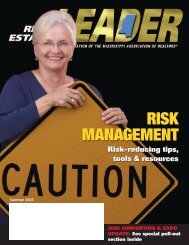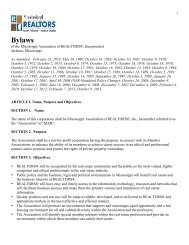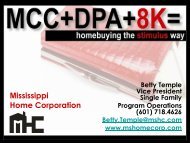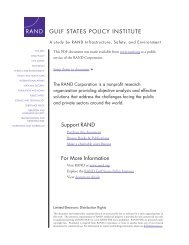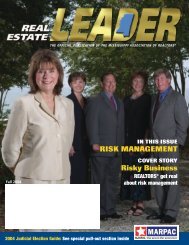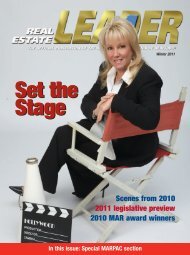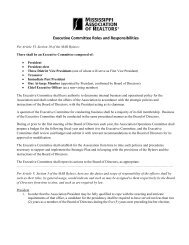life's highway - Mississippi Association of REALTORS
life's highway - Mississippi Association of REALTORS
life's highway - Mississippi Association of REALTORS
Create successful ePaper yourself
Turn your PDF publications into a flip-book with our unique Google optimized e-Paper software.
or cannot make the payment altogether. When this happens, the client only<br />
has a few options to avoid the payment shock <strong>of</strong> a higher rate: 1) refinance<br />
into a fixed rate mortgage, 2) sell the property, or 3) contact the lender and<br />
work out a loss mitigation solution to change the rate and terms <strong>of</strong> the loan.<br />
In many cases, homeowners utilized a subprime loan as it was originally<br />
designed - as a stepping stone to buy a home today and take the next few years<br />
to get their credit issues corrected. A mortgage paid on time would have a<br />
very positive impact on their credit report. When the time comes for the rate<br />
to adjust or the prepayment penalty expires, those homeowners could refinance<br />
their home into a prime fixed rate loan with good success. However,<br />
not all homeowners are that diligent, and if their poor credit management did<br />
not improve over the course <strong>of</strong> the fixed rate period, they would not be in a<br />
very good position at the time <strong>of</strong> the rate adjustment or end <strong>of</strong> the prepayment<br />
period.<br />
S<strong>of</strong>tening home prices in many areas <strong>of</strong> the nation including <strong>Mississippi</strong> have<br />
exacerbated the problem. When the payment increases and home values have<br />
fallen, it creates a disastrous position for the homeowners caught in the middle.<br />
Refinancing would no longer be an option. Selling the home for what the homeowner<br />
owes would be an issue. Therefore, those homeowners are left to stare<br />
foreclosure in the face.<br />
Another contributing factor to this crunch is a loan product called a Pay<br />
Option ARM. This loan product differs from a subprime loan in a few ways, but<br />
most notably in the fact that it is generally only available to borrowers with a<br />
credit score greater than 700. The product derives its name from the terms <strong>of</strong><br />
the mortgage. The borrower has the option to select one <strong>of</strong> four general payment<br />
options. These options include: 1) a partial interest payment at an introductory<br />
or teaser rate, 2) an interest only payment, 3) a fully indexed principal,<br />
interest, taxes and insurance (PITI) payment based on a 30-year amortization,<br />
or 4) a fully indexed principal, interest, taxes and insurance (PITI) payment<br />
based on a 15-year amortization.<br />
These loans are the ones that you hear on the radio that <strong>of</strong>fers…”the low<br />
fixed introductory rate <strong>of</strong> .25 percent…that’s right…only .25 percent.” You<br />
know the ones I’m talking about…the ones that claim…”you can buy a<br />
$750,000 home for only $272 a month!”<br />
What you don’t hear in those commercials is the fact that with option one<br />
you are negatively amortizing your loan. In other words for every month you<br />
make that low payment, your principal mortgage balance goes up. Typically, the<br />
lender will allow you to carry your principal balance up to 115 percent <strong>of</strong> the<br />
original purchase price. Once it hits 115 percent, the lender will then only allow<br />
a full PITI payment. Payment option two is not as bad, since you are at least paying<br />
all <strong>of</strong> the interest, but you are still not reducing your principal. Payment<br />
option three or four is the safe payment where you pay all the interest and some<br />
<strong>of</strong> the principal, but you can imagine when the homeowner is given a choice…it<br />
is very easy to just pay that minimum monthly payment.<br />
The Pay Option ARMs have been wildly popular in areas <strong>of</strong> the country where<br />
property values have climbed so high that the common borrower needed a solution.<br />
The states <strong>of</strong> California, Florida, Nevada, Arizona and New York are saturated<br />
with this type <strong>of</strong> loan product. An Account Representative with one <strong>of</strong> the<br />
largest banks in the country went so far as to tell me that the Pay Option ARM in<br />
Florida is equivalent to the 30-year fixed rate mortgage in <strong>Mississippi</strong>.<br />
For some very sophisticated borrowers, this loan program is very successful.<br />
However, what happens when the growth <strong>of</strong> property values comes to a halt<br />
or even worse begins to decline and the principal balance on the homeowner’s<br />
mortgage is at 115 percent<br />
<strong>of</strong> the original purchase<br />
General lending trends price? The payment shock<br />
Over the last several years, subprime lending in for the homeowner to go<br />
<strong>Mississippi</strong> has steadily increased. Between 1997 from paying .25 percent<br />
and 2004, the percent <strong>of</strong> conventional home interest only to a full PITI<br />
purchase mortgage loans made by subprime payment is substantial. If<br />
lenders increased from 1.9 percent to 14.2 percent.<br />
In 2005, <strong>Mississippi</strong> had the highest rate <strong>of</strong> cent more than it is worth,<br />
they now owe 10-15 per-<br />
subprime lending in the country (38.8 percent). refinancing or selling the<br />
The rate was 11.5 percentage points higher than home is not an option without<br />
substantial cash…and<br />
the national rate.<br />
they too will be stuck facing<br />
Source: <strong>Mississippi</strong> Economic Policy Center the higher payment or<br />
worse foreclosure.<br />
Unfortunately, <strong>Mississippi</strong> is not immune to either <strong>of</strong> the two primary causes<br />
<strong>of</strong> the tightening <strong>of</strong> the mortgage market. Certain areas <strong>of</strong> the state are clearly<br />
affected more than other areas. Not surprisingly, the areas most affected by<br />
this issue are the areas with our greatest population bases. The Jackson<br />
Metropolitan Statistical Area (MSA) is made up <strong>of</strong> Hinds, Rankin, Madison,<br />
Copiah and Simpson counties. In a recent study released by the <strong>Association</strong> <strong>of</strong><br />
Community Organizations for Reform Now, the Jackson MSA ranked fourth in<br />
(continued on page 12)<br />
11 / MISSISSIPPI REAL ESTATE LEADER / Fall 2007



